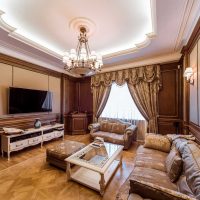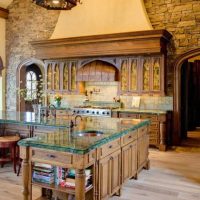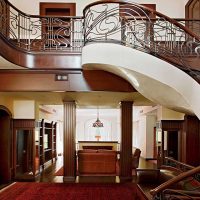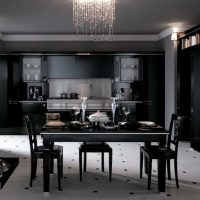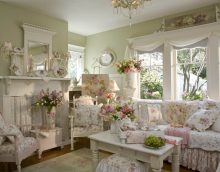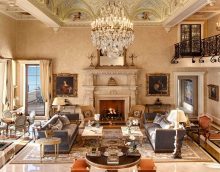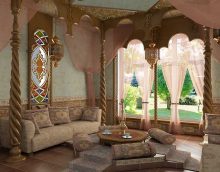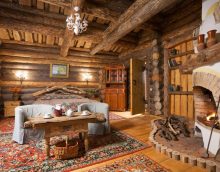Medieval simplicity and luxury interior: Romanesque style
Romanesque style in the interior was formed in Catholic European countries in the XI-XII centuries. under the strong influence of the Byzantine trend in the design of houses of the medieval aristocracy. At that time, this type of design was called "Roman" and evolved on the basis of a reviving interest in the ancient heritage. Indeed, the Romanesque interiors are a bit like the interior decoration of ancient Roman villas. Over the centuries, the Romanesque style has become a completely independent direction.
Every corner of Europe has formed its own direction within the framework of romanticism. Its characteristic features were manifested both in Old Russian architecture, and in the architecture of Italy, England or France. In the Middle Ages, the creation of interior interiors was available only to a few classes, so the main emphasis was on decorating churches and castles. In the modern world, meticulously following the canons of the Romanesque style is almost impossible, and it will be appropriate only in the homes of true fans of medieval themes. But some elements are used quite often to create restrained and noble premises.

Romanesque style appeared in the 11th century

Romanesque design has a lot to say about the owners

Wood combined with stone looks very expensive and beautiful.
Content
- 1 General characteristic of the Romanesque style
- 2 Roman style house
- 3 Floor finish
- 4 Ceiling decoration
- 5 Wall decoration
- 6 How to choose furniture?
- 7 Romanesque style in the interior of the kitchen
- 8 The decoration of the medieval bedroom
- 9 How to make a bathroom?
- 10 Video: Romanesque style
- 11 50 photos of interior design ideas in the Romanesque style:
General characteristic of the Romanesque style
This is one of the oldest areas of design, so its main features have long been established and are easily recognizable. These include:
- simplicity of interior and decoration;
- minimum number of decor items;
- a carved line in the shape of a zigzag to decorate the room;
- dark wood furniture;
- a mandatory element - statues in the antique style, busts of thinkers and poets of antiquity;
- large vases, oval mirrors, lamps and candlesticks made of bronze;
- for floor and wall decoration, ceramic tiles, wood panels, plaster, mosaic are used.

In the Romanesque style, very few decorative elements

Most often, tiles or wood are used to finish the floor
Decoration Features
|
Floor |
Stone, less often parquet |
|
Walls |
Facing stone or rough plaster, a combination of them is possible |
|
Ceiling |
Vaults, imitation of ceilings in castles |
|
Window |
Semicircular windows of small size, remotely resembling loopholes, but more elegant |
|
Doors |
Semicircular openings, massive doors |
|
Furnishings |
Simple, slightly rough forms |
|
Decor |
Vases, mirrors, candlesticks, statues and busts similar to ancient sculptures |

The ceiling can be made in the form of patterns

The furniture is simple and crude.

For wall decoration use stone or plaster
Roman style house
Medieval interiors are more suitable for decorating cottages and country houses, in the small space of standard city apartments it is difficult to create a magnificent decoration of an ancient castle. But when designing a house, even at the stage of its construction, you can take into account some features, for example, make thick walls and semicircular windows.
The building itself should harmoniously fit into the surrounding nature, combine a simple architectural appearance with a laconic exterior decoration.At the same time, the interior decoration of the house looks very different: it stands out against the background of other areas of elegance and grandeur. Due to the rich historical traditions, the appearance of the Romanesque interior differs in some monumentality.
Do not forget that medieval architecture is the temples built to communicate with God, and the fortresses created to protect against enemies. The very purpose of architectural complexes does not imply a florid appearance.

Romanesque style is more suitable for country houses and cottages.

Interior and exterior are most often different
Floor finish
Romanesque style in the interior requires a few mean finish flooring. A facing stone or a not too bright mosaic is best suited for these purposes. Since such a floor turns out to be quite cold (both in terms of its temperature and its appearance), various carpets and even animal skins are quite allowed.
In modern houses, you can use black and white tiles or dark wood parquet. In mosaic patterns, zodiac signs are most often found (the Middle Ages - the heyday of astrology), stars and geometric figures in different combinations.

Most often, tiles are used to finish the floor.

Wood flooring is also suitable for Romanesque style

A special feature of the Romanesque style is the dark wood.
Ceiling decoration
High vaulted ceilings, the color of which often coincides with the color of the walls, are considered characteristic for this stylistic direction. To revitalize the surface are widely used:
- wood inserts;
- rough backups;
- frescoes;
- Art murals that came into fashion back in the Renaissance.

Usually high ceilings in this style

The use of wood inserts is also appropriate.
Wall decoration
As a rule, designers are advised to use materials that imitate stone and create the illusion that the room is in a medieval castle. Therefore, neither the wallpaper nor the paint will be authentic. But such design options as:
- facing stone;
- wooden modules;
- beige, gray or light brown stucco.
To avoid the monotony of the walls, you can decorate them with frescoes, tapestries, lamps, paintings, stained glass windows or paintings in massive frames painted in the spirit of the Renaissance masters.
A characteristic feature of medieval interiors is a wall ornament with floral patterns, animal figures, geometric figures intertwined with elaborate curls.
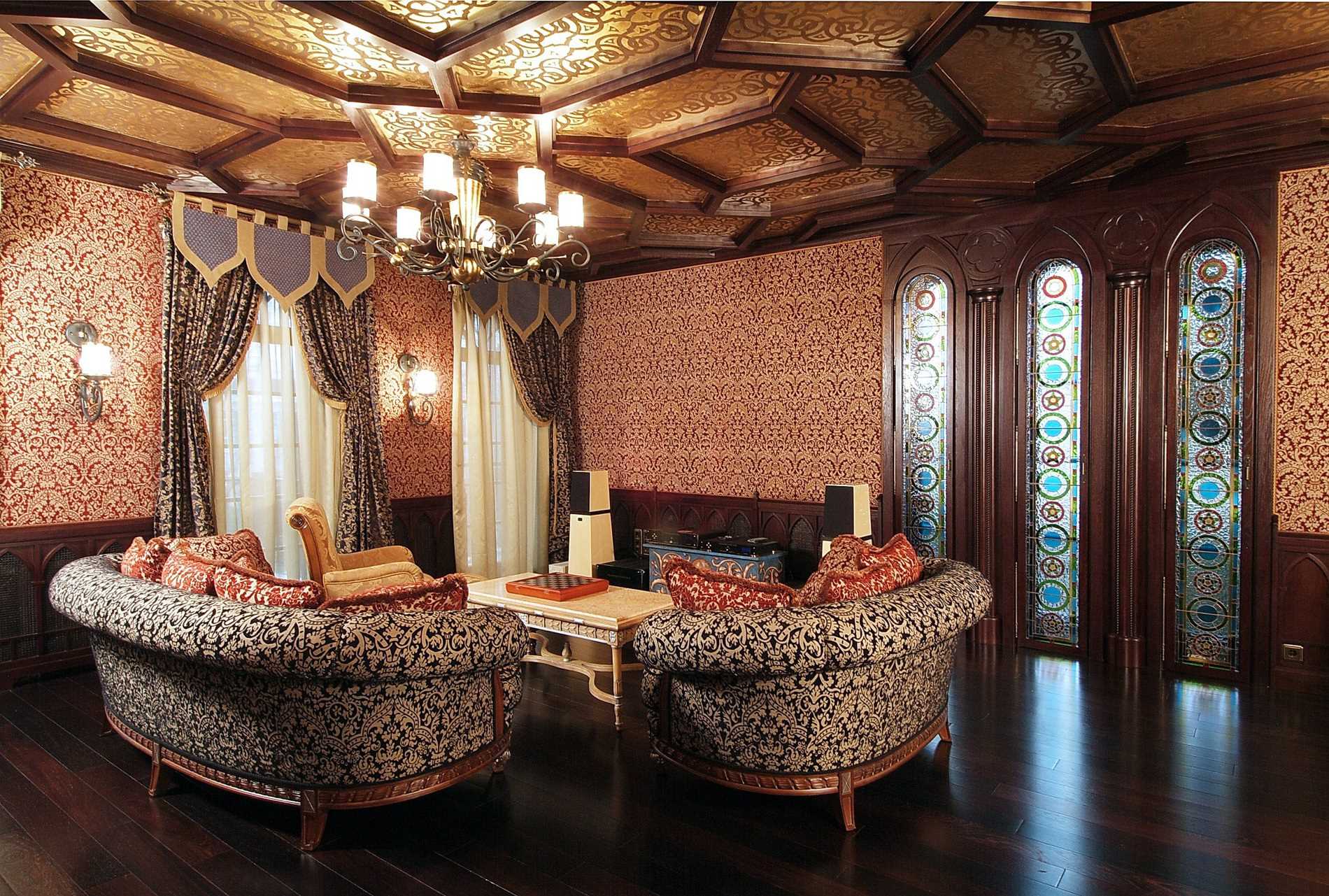
For wall decoration, it is best to use stone or wood.

Walls can be decorated with various objects.
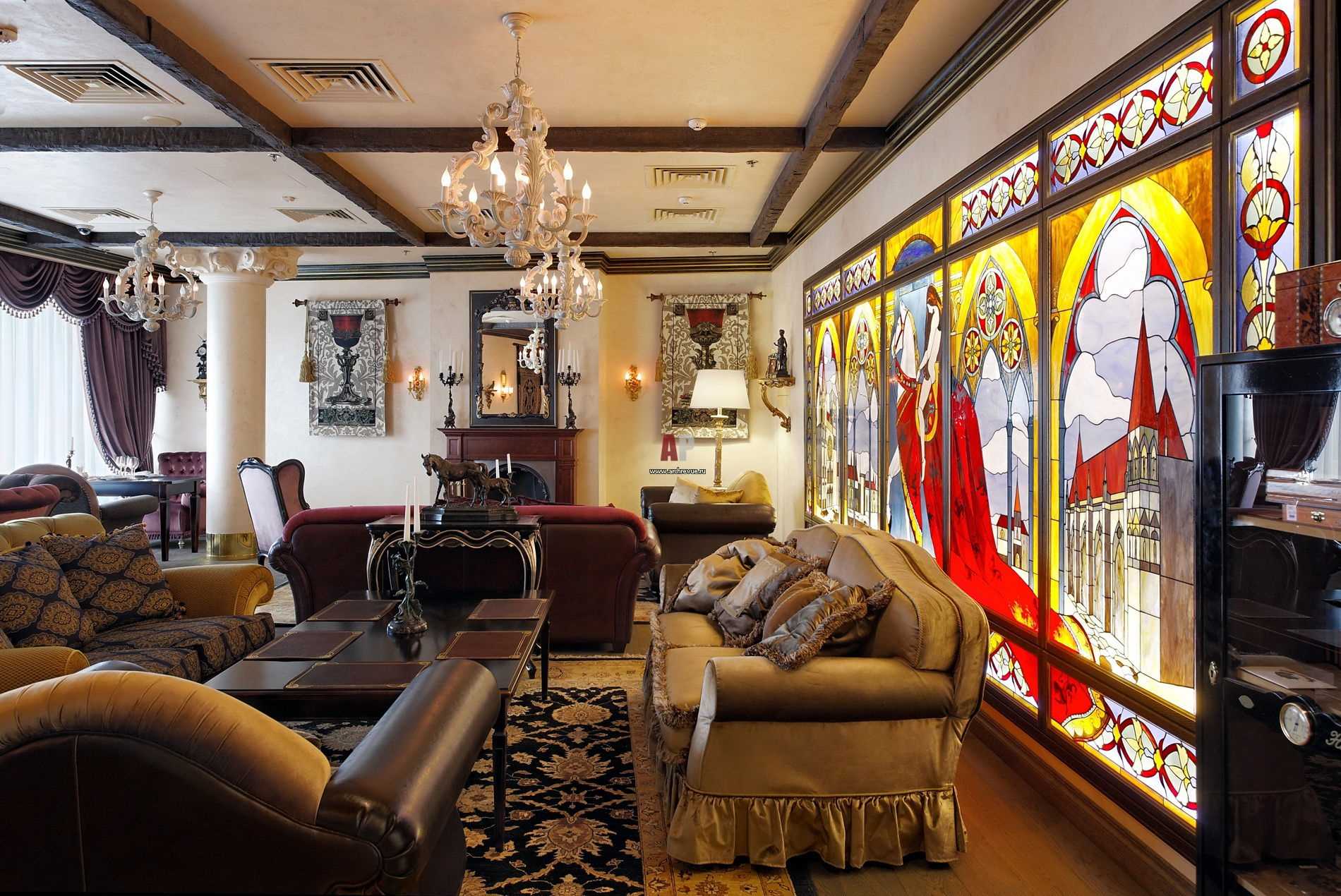
You can also finish with plaster
How to choose furniture?
Authentic medieval furniture is unlikely to appeal to a modern person accustomed to comfort. Tables and cabinets, knocked together from rough boards, sofas and chairs without fabric upholstery, can not be called comfortable. Perhaps, only large chests or dressers decorated with cast-iron upholstery are suitable for modern design in the Romanesque style. The rest of the room’s furnishings are best simply styled in the Middle Ages.
Fancy forms of furniture should be avoided: only simple shapes and smooth lines. It is possible to finish furniture items with iron parts or painted in white, red, brown or black.
The outward simplicity of furniture can be combined with high quality material and beautiful decorations: expensive woods decorated with elaborate carvings with bizarre floral ornaments will add an ascetic medieval atmosphere of luxury and elegance.

Furniture is best used in dark wood.

Furniture is usually used without upholstery.
Romanesque style in the interior of the kitchen
If the kitchen is small, in order to create a successful design in medieval traditions it is better to combine it with the living room or dining room.The working area, all hanging cabinets should be chosen wooden. The refrigerator should either be styled like wood or hidden in a cupboard, like other household appliances. Gas stoves and dishwashers are unlikely to harmoniously look against the background of stone walls and ceiling arches, stylized under the architectural features of ancient European castles and fortresses.
In the dining area, a rude table surrounded by many massive chairs will authentically look. To illuminate the space, it is better to use a large ceiling chandelier with bulbs resembling a candle flame.

On the walls usually use drawings
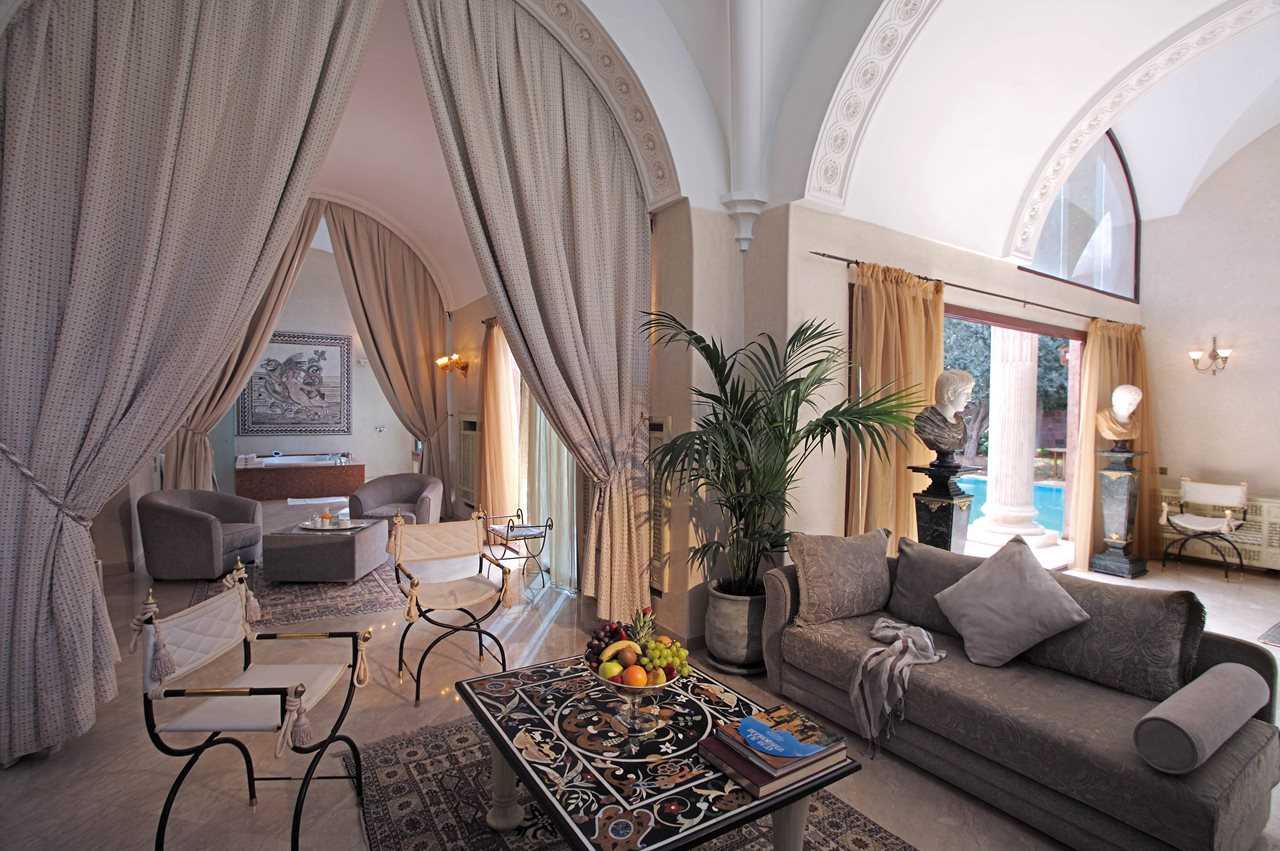
The living room can be combined with the kitchen.

Porcelain tile is perfect for decoration
The decoration of the medieval bedroom
The central element of the interior of the Romanesque bedroom is a massive, wide bed, often with a canopy. If in ancient times canopies were of great practical value in the fight against insects, nowadays they provide an opportunity to express your imagination and personality. A beautiful way to decorate a room will be a bedspread made of natural fabric, on which numerous pillows of different sizes are placed.
Any bedroom is a great place to use textiles, even in a rather restrained medieval design. You can decorate the windows with heavy curtains made of dense fabrics with lambrequins, brushes, and hacks. Multilayer curtains will be no less relevant. Mandatory in the decoration are grip for curtains.

Candles perfectly complement the style of the room.

The bed in the room should be large
How to make a bathroom?
Bathroom - a truly unique room for the chosen direction. Its functional purpose is foreign to the medieval era. In Catholic countries, hygienic procedures were considered pleasing the flesh, almost a sin, the knights boasted that they had not taken off their boots for years. But such a contradiction will not prevent the modern designer from sustaining the bathroom in the Romanesque style, applying its main features.
For the bathroom, you need to choose a large room in which the central place will certainly be occupied by a bathtub, tiled or stone. For decoration, stone soap dishes and dispensers, candlesticks and coasters are suitable.
Modern living conditions impose certain requirements for comfort, not always compatible with the Romanesque style. But its individual features are becoming increasingly popular, turning into another trend of designer fashion.
Video: Romanesque style








